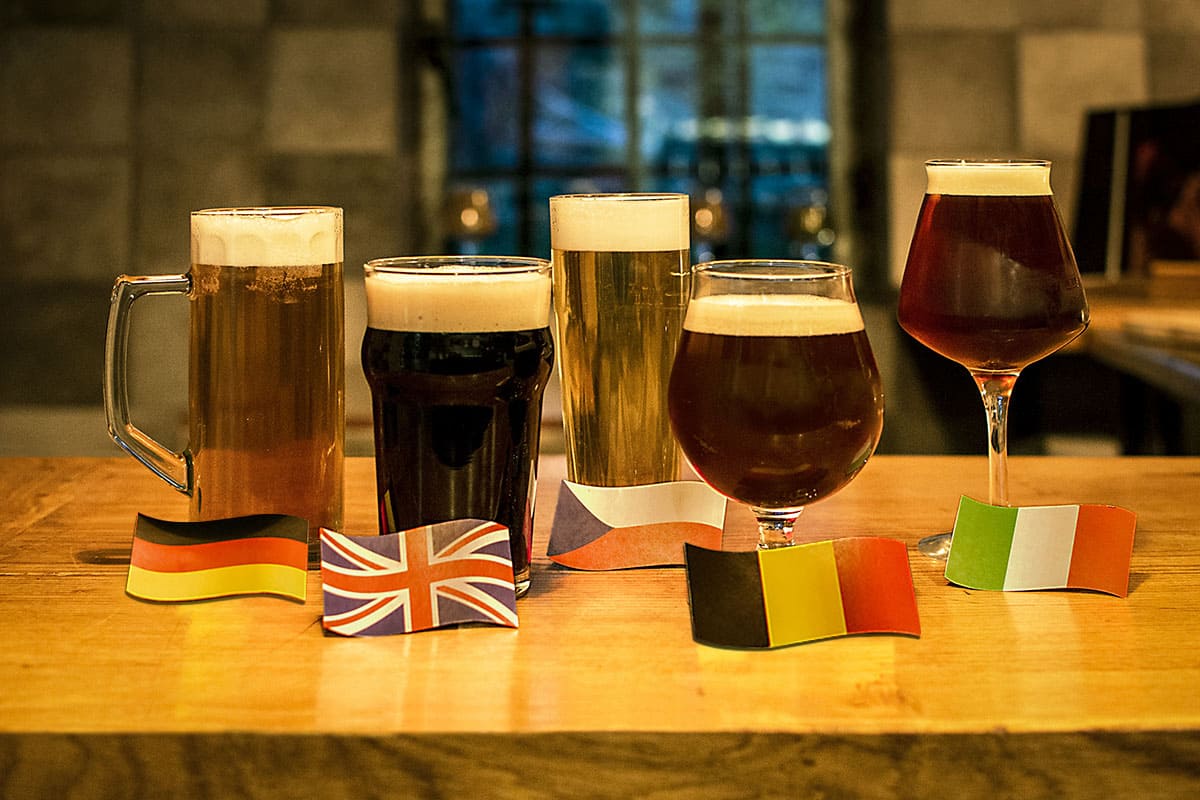Beer styles around the world: the origin of every beer

The rich and varied world of beers can be divided into styles, i.e. types of beer that share common historical, production and organoleptic traits. Knowing beer styles means knowing how certain types of beer originated and became popular, and what role they often played in the social customs of a country.
The three main types of beer: top-fermentation, bottom-fermentation and spontaneous fermentation
All beer styles can fall under one of the three families into which the world's brewing heritage is divided. The two main groups - which cover almost all world beer production - are top-fermented and bottom-fermented beers. The main difference is the type of yeast used:
- Saccharomyces cerevisiae in the first case, which works best at temperatures between approximately 13 and 23 °C
- Saccharomyces pastorianus in the second, used at temperatures between 7 and 10 °C.
In top-fermented beers (also known as Ales), yeast can play a major role in terms of aromas, which is hardly ever the case in bottom-fermented beers (also known as Lagers).
An additional, very small family includes spontaneously fermented beers. These, unlike the other two, do not involve the inoculation of yeast by the brewer: the warm wort is left in contact with the air and ferments thanks to the micro-organisms that are naturally present in the environment.
Each brewing style has its roots in the culture of a country or region. For obvious historical reasons, most styles come from countries where beer has always been the most popular drink: Germany, United Kingdom, Belgium, Czech Republic and, more recently, the United States. Some styles, however, are associated with other countries.
England: English beers
In addition to being the country where pubs have always been more of a social institution than just a bar, England is one of the homelands of top-fermented beers. English yeast strains generally have little character and it’s mainly malts and/or hops that contribute to the flavor profile.
Porter and Stout
England has a very long tradition of “brown beers” - dark beers from which distinct styles have emerged over time. One of the most famous was the Porter style, which spread to London and the rest of the country with the advent of the Industrial Revolution. Porters were successful for a long time, but in the 19th century they were replaced by paler (amber) products, and the future of dark beers was left in the hands of Stouts.
Similarly to Porters, Stouts are also characterized by notes of coffee, chocolate and licorice due to the use of dark malts. They have been so successful that they have generated several variations over time. We have the stronger Russian Imperial Stouts, brewed by English breweries for tsarist Russia; Sweet Stouts and Oatmeal Stouts, made with the addition of lactose and oats, respectively; Export Stouts for foreign markets and Oyster Stouts, brewed with oysters.
Bitter/Pale Ale
England’s staple beers are Bitter beers, also called Pale Ales. They became popular in English pubs during the 19th century, replacing Porters. They revolutionized the market with their “Pale” color, at least in comparison with the “brown beers” that were popular at that time. Bitters are easy to drink, with malty notes of biscuit, dried fruit, a slight roasted note and a delicately bitter finish.
India Pale Ale
At the beginning of the 19th century, the Bow Brewery in London was already producing its “India beers”: amber-colored, hopped beers brewed for the British colonies in India. However, the London brewery lost the favor of the East India Company, which began to make agreements with the brewers of Burton-on-Trent, an important brewing town in Staffordshire, asking them to replicate the characteristics of the “India beer” brewing style.
This is more or less the genesis of India Pale Ales, a more hopped version of the Pale Ale style, with a higher alcohol content. In their modern version, they represent the signature style of the global craft beer revolution. As a matter of fact, this beer style, which had virtually disappeared, was later revived by American breweries.
Mild and Barley Wine
The history of English beer has always been characterized by the contrast between mild beers - drunk fresh, as soon as they are ready - and stale beers, which age for months or even years. Today, we find the legacy of this tradition in two beer styles: Mild beers and Barley Wines.
Although many different versions existed in the past, today the term Mild refers to a reddish-brown, very light beer with notes of hazelnut, caramel and roasted hints. Milds were very successful in the mid-20th century, when they became popular among the working class in London.
Barley Wines, on the other hand, are the beers with the highest alcohol content among English styles: they are strong, complex, they tend to be sweet and should be enjoyed in small sips. They are left to age in the cellar for a long time. Often, they are also called Old Ales.
Belgium: Belgian beers
Along with England, the other country of reference for top-fermented beers is Belgium. Here, however, the yeast becomes the protagonist, often defining the flavor profile of the beers with its fruity and spicy notes. Belgium - and in particular a small area south-west of Brussels - is also the home of Lambic and spontaneously fermented beers, a small treasure in the international beer scene.
Saison
As in the rest of north-central Europe, farms in Belgium have been important beer production centers in the history of local beer. It was in this context that the Saison style originated. Legend has it that is was he refreshing drink for the saissoniers, the seasonal laborers who came to Wallonia in early summer to help out in the fields.
Often brewed with spices and a small amount of cereals other than barley (rye, spelt, wheat), they are complex but also easy to drink and are characterized by citrus and spicy notes and a dry, delicately bitter finish.
Dubbel and Tripel
Monasteries are another important production beer center. They are the home of the Trappist beer tradition. This name does not denote a specific style: a Trappist beer is brewed within a monastery of the Order of Cistercians of the Strict Observance, following very strict specifications, but it can belong to any type of beer style (although some styles are specific to the abbey tradition).
Dubbels are deep amber-colored, complex beers with a sweet touch, where both the malts (notes of caramel and chestnut honey) and yeasts (prunes, dates, sultanas) contribute to the flavor profile. Records show that they were produced as early as the Middle Ages, before disappearing only to be rediscovered after the Napoleonic era.
Tripels, instead, were created in more recent times: the first was brewed by the Westmalle brewery in the 1930s. These are pale beers with notes of yellow-fleshed fruit, citrus, banana, pepper and cloves; they have a full body and have a very well balance between the sweet and bitter components and the final dryness.
Blanche
The typical wheat beers of Belgium belong to the Blanche style, also known as Witbier. They are brewed with a high proportion of unmalted wheat and flavored with the addition of coriander and bitter orange peel. They have a light, milky color, they are fresh and thirst quenching, with a flavor profile that combines spicy and citrus sensations, before a delicately acidic finish.
Oud Bruin and Flemish Red Ale
Two of the oldest beer styles that have survived to the present day originate from the sour beer tradition of Flanders. Both Oud Bruin beers (East Flanders) and Flemish Red Ales (West Flanders) are characterized by a reddish-brown color and a pronounced acidity - lactic in the former case, acetic in the latter. This is balanced by a good malty texture and a relatively complex flavor profile. They are mixed fermentation beers, as they involve the (controlled) contamination of wild yeasts and bacteria.
Lambic and Gueuze
Lambic is the ultimate spontaneously fermented beer. Typical of a small rural area called Pajottenland (south-west of Brussels), these beers are produced without any yeast inoculation by the brewer. After boiling, the wort is transferred to open cooling tanks and exposed to the microorganisms (wild yeasts and bacteria) that are naturally present in the air. These activate the fermentation and long maturation process, which happens entirely in wooden barrels.
After a long aging period (six months to three years), the result is a distinctly sour beer with notes of cellar, chicken coop, cardboard, but also wildflowers, cider and citrus. From Lambic comes Gueuze, usually made by blending three different vintages (one, two and three years). Naturally refermented in the bottle (it has a rather strong carbonation), Gueuze is very similar to Lambic, but is generally more elegant.
Kriek, Framboise and Fruit Lambic
In the Lambic tradition, it is not uncommon to add fruit to the recipe to obtain completely different products. Kriek is made with the addition of macerated sour cherries, while Framboise is made with raspberries. We can also find Fruit Lambics made with grapes, plums, apricots, peaches, etc. In all these cases, the special characteristics of the fruit complement the peculiarities that come from the spontaneous fermentation.
Germany: German beers
Germany is the most important country for bottom-fermented beers. Here, Lagers began to spread systematically during the 19th century, causing the disappearance of many top-fermented styles. But perhaps what most influenced the local brewing culture was the introduction of the Reinheitsgebot (the Purity Order) in 1516. First in Bavaria and then in the rest of the country, it prevented brewers from using ingredients other than barley, water and hops (besides yeast, of course).
Dunkel and Helles
Typical of Munich, Dunkel and Helles beers can be considered the staple beers of Germany. Dunkels, which probably appeared around the 16th century, are amber-brown beers with a rich malty component and good overall balance. Their aromas are reminiscent of caramel and hazelnut, with roasted hints. In the 19th century they began to be replaced by Helles: golden, balanced beers with a sweet mouthfeel, created to follow the recent success of Pils in Bohemia.
Weizen
Top-fermented Weizen are the typical wheat beers of Germany. They are easily recognizable by their hazy appearance (found in almost all versions of Weizen), but especially by their distinctive notes of ripe banana and clove. The percentage of malted wheat can be as high as 70%, and they are refreshing, easy to drink and just slightly acidic. Their revival started in the 1960s.
Bock and Doppelbock
Germany's classic strong, winter beers are called Bock, and were already popular in the 14th century in the town of Einbeck in Lower Saxony. They have a relatively high alcohol content (at least by German standards) and are characterized by a medium body, a certain sweetness, and a distinctive malty component. One variation is the Doppelbock style. The progenitor beer of this style was the Salvator, brewed by the Paulaner monks in Munich in 1774, from which the Paulaner brewery originated. Doppelbocks are malty, hoppy, full-bodied and high in alcohol. They boast a rich flavor profile, often marked by notes of caramel, roasted hints and dried fruit.
Kölsch and Altbier
The advent of Lagers in Germany did not wipe out all top-fermented styles. In the cities of Cologne and Düsseldorf, two types of top-fermented beers have survived to this day. We can consider them as evidence of an ancient way of brewing beer:
- Kölsch, typical of Cologne, are pale, extremely easy to drink, dry, slightly bitter and with a nice floral and honeyed flavor profile
- Altbier, typical of Düsseldorf, are amber-brown in color and have notes ranging from nutty to lightly toasted, and a smooth body.
Both types involve a long cold maturation process (called lagering) and can be drunk in old city inns, tapped from barrels and served in small cylindrical glasses.
Czech Republic: Czech beers
The country with the highest per capita consumption of beer in the world, the Czech Republic, has a rich brewing culture, strongly influenced by Germany. Many local beer types are based on German styles, yet it was in the Czech Republic that the most revolutionary style ever was created: Pilsner beer.
Pils
The first Pils in history was brewed in October 1842 in the city of Plzen by a Bavarian brewer named Josef Groll. For his new beer, Groll used innovative pale malts, a bottom-fermenting yeast, and two key local ingredients: Bohemian Saaz hops and the town's light, sweet water.
That beer, which would later become Pilsner Urquell, shocked the market with its crystal-clear golden appearance, elegant flavor profile, and bitter yet balanced finish. A new way of understanding beer had emerged, and it would contribute to the birth of many other "pale" styles.
United States: American beers
The United States are currently the most important scene for the international craft beer market. The "craft revolution", which began in the late 1970s, developed by adopting and reinterpreting classic European beer styles, as well as by reproducing ancient local ones. The US are the home of hopped beers, in their many different sub-styles.
American IPA
American IPAs can be considered the reinterpretation of English IPAs by American brewers, adapted to local taste and ingredients. The first modern American IPA was Anchor Brewery's Liberty Ale (1975), but the term was first used in 1982 by Yakima Brewing. American hop varieties take center stage and give intense citrus, resinous, and tropical notes, as well as a definite bitterness.
Double IPA
In 1994, Blind Pig Brewery's Inaugural Ale was created. It pushed the characteristics of American IPAs to the limit: it was more bitter, with a higher alcohol content, and more hoppy than your standard American IPA. It was the first Double IPA in history, and it would be replicated by hundreds of breweries in the United States and beyond.
American Pale Ale
Before the success of American IPAs, the staple beers in the United States were American Pale Ales, which emerged in the early 1980s. Compared to British Pale Ales, they are lighter in color, the focus is primarily on hops (with notes that can range from citrus to resinous to tropical and to stone fruit), and malts or yeasts play virtually no role in creating the flavor profile.
California Common and Cream Ale
Among the many styles that were popular before the craft revolution, and which would later be revived by craft breweries, we can find California Commons and Cream Ales.
- California Commons are old beers from the San Francisco area, brewed with bottom-fermenting yeasts which are left to work at high temperatures, using open cooling tanks. This brewing style was revived in the 1970s by the Anchor Brewery, which registered the name Steam Beer. These are light amber beers with aromas of traditional American hops (balsamic, rustic), notes of caramel and roasted hints, and gentle fruity nuances.
- Cream Ales, instead, are top-fermented beer, but are brewed like bottom-fermented ones; they appeared in the 19th century to counter the rise of Lagers. They survived Prohibition in a lighter and gentler version. They are pale, very carbonated, well-balanced and dry They are brewed with six-row barley and a fair percentage of other grains (maize, but also rice and others).
France, Italy and other countries
Although most beer styles belong to a few major brewing countries, there are exceptions.
- Bière de Garde, reminiscent of the neighboring Saison in Belgium, has developed in northern France. Compared to Saisons, these beers are more malty and less bitter and spicy. Historically, they were produced in early spring and aged for a long time at low temperatures to be consumed during the summer.
- In recent years, the Italian Grape Ale style has emerged in Italy, as the link between beer and wine IGAs are made with the addition of grape must or (more rarely) fresh grapes. They can be pale or dark, light or strong, sour or non-acidic, straightforward or aged in wooden barrels. What matters is that the contribution of the grape variety is perceptible, but without overpowering the beer soul.
- Finally, we can mention the Finnish Sahti, a strong, sweet farmhouse beer made with rye and juniper, and the Polish Grodziskie, a beer made with smoked wheat, highly carbonated, dry and refreshing.
The phenomenon of beer tourism
If we think of the many origins of each brewing style and the differences that characterize the brewing habits of different countries, it’s easy to see why beer tourism is a rising phenomenon that is destined to become increasingly important. It meets two needs: on the one hand, it is a way to discover brewing styles in the contexts where they originated and grew; on the other, it is a way to explore the places where beer is brewed.
Especially in the United States, beer tourism is very popular and developed, thanks also to the high quality of the accommodation services available. In Europe, it is a growing trend and will be an important driver for the future of craft beer.



